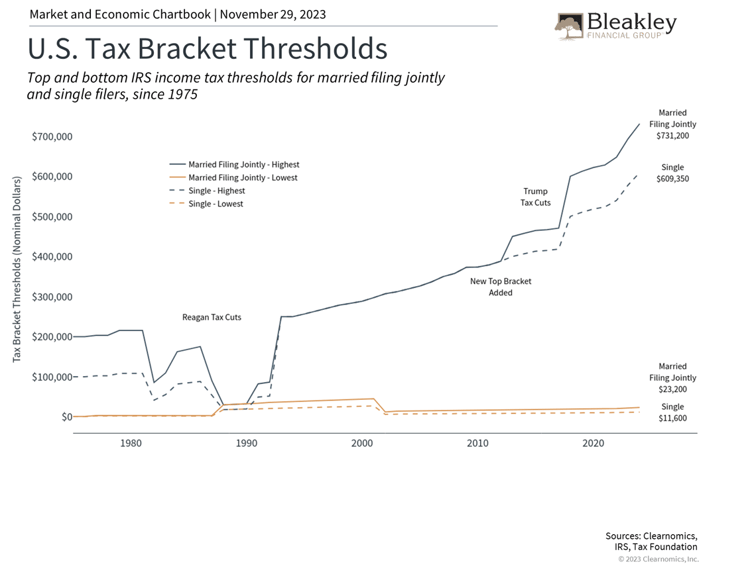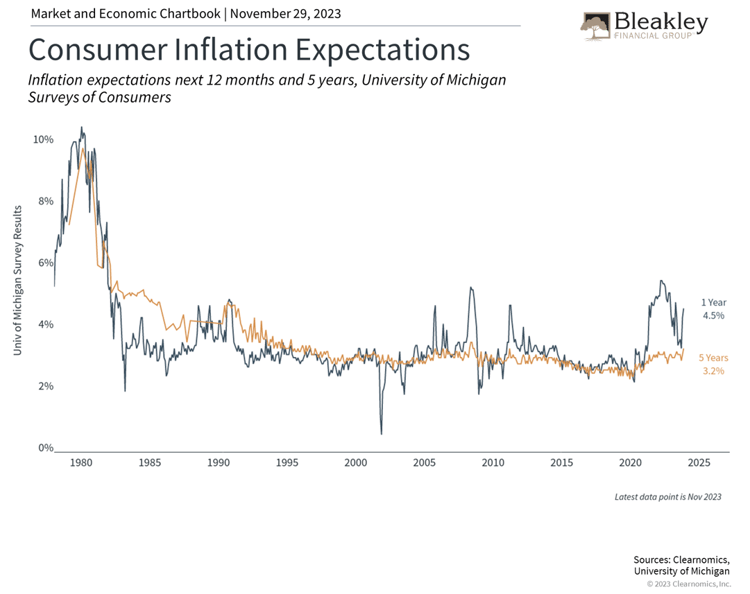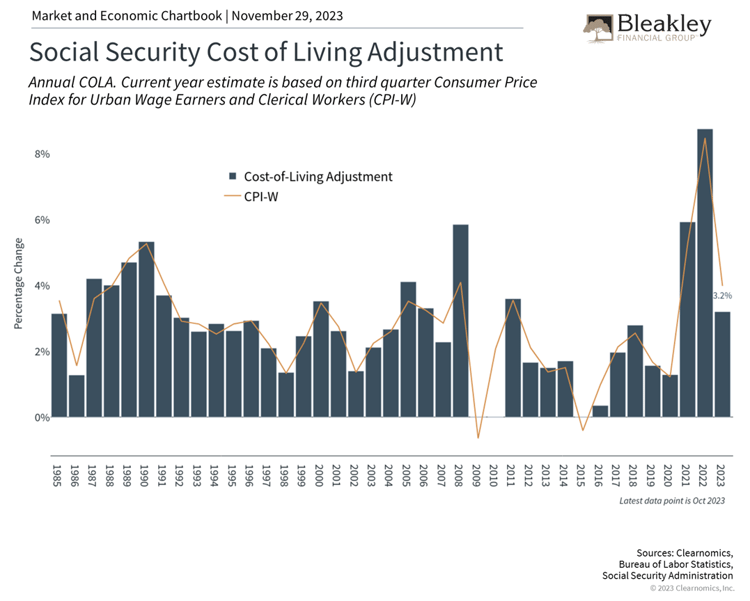While the holiday season is ideally a time for family and friends, it is also the best time to review tax strategies for the coming year. Tax planning includes topics such as tax-loss harvesting, choices of investment vehicles, optimizing the order of withdrawals, and many others. Given the complexity of these tax considerations, it’s important to work with a trusted financial advisor or planner to best understand each approach and its implications. It’s also important to understand the economic climate's effect on taxes, especially the impact of inflation. What do investors need to know as they plan for the coming year?
Tax Bracket Thresholds are Adjusted for Inflation?
While inflation is effectively a hidden tax on consumers in that it reduces the purchasing power of cash, it also has an impact on actual tax bills. This is because incomes tend to rise in inflationary environments due to higher wages. Left unchecked, this can lead to “bracket creep” in which growing nominal incomes push taxpayers into higher tax brackets. To prevent these distortions, the IRS adjusts federal tax brackets each year based on inflation rates.

In 2024, this adjustment amounts to a 5.4% increase in tax bracket thresholds and standard deductions. The top tax bracket will start at $731,200 for those with a status of “Married Filing Jointly,” up from $693,750 in 2023, while the lowest tax bracket has a ceiling of $23,200 instead of $22,000. The same increases apply to other filing statuses but it’s important to note that not all parts of the tax code receive these adjustments. Additionally, these adjustments only directly impact federal taxes, not state and local ones. In fact, the federal deductions for state and local taxes are not adjusted for inflation. Again, due to these nuances, it’s important to consult a professional when making tax decisions.
On a technical note, the IRS uses what is known as the “Chained CPI For All Urban Consumers” (C-CPI-U) for these adjustments. This differs from the typically quoted CPI numbers by better accounting for changes in consumer spending patterns, making it arguably more accurate over time. This is referred to as the “substitution effect” since consumers can change their behavior as the prices of goods rise and fall. However, chained CPI-U has also historically been lower than traditional CPI measures, potentially impacting the benefits taxpayers receive.
Consumers Expect Higher Inflation
While inflation has improved significantly over the past year, recent economic data also suggest that consumers expect inflation to remain higher for longer. The latest data from the Surveys of Consumers by the University of Michigan show that consumers expect inflation to average 4.4% over the next year, an increase over the last two months from 3.2%. Consumers also expect inflation to average 3.2% over the next five years, a jump from the 2.8% in September and well above the 2% target the Fed hopes to achieve by 2026. While these short-term fluctuations may be the result of factors such as swinging energy prices and interest rates which have already reversed somewhat, they also reflect the uncertainty all consumers face in this economic environment.
 Ironically, this tax and inflation discussion comes at a time when the government is facing difficulty agreeing on a budget in the House of Representatives. The government should have originally agreed to a new budget this past September but instead enacted a short-term funding plan that kicked the can down the road until November 17. Unfortunately, that deadline is now fast approaching.
Ironically, this tax and inflation discussion comes at a time when the government is facing difficulty agreeing on a budget in the House of Representatives. The government should have originally agreed to a new budget this past September but instead enacted a short-term funding plan that kicked the can down the road until November 17. Unfortunately, that deadline is now fast approaching.
At the time of this writing, the House is considering a two-step continuing resolution to keep some important government services funded through January 19 (Veterans Affairs, the Department of Energy, the Department of Transportation, etc.) and others through February 2 (Department of Defense, the State Department, etc.). If this fails to pass, the House may turn to a bill that will keep spending flat for one year. Whichever scenario plays out, it's likely that this budget battle will bleed into 2024 just as the presidential election heats up, and as we approach the next debt ceiling increase in early 2025.
This is relevant to investors and taxpayers because these political challenges stem from underlying fiscal issues, namely the size of the federal deficit and debt. These problems have resulted in both political gridlock in deciding on a budget as well as during debt-ceiling increases. Unfortunately, these are long-term problems that are only likely to worsen. Many economists and investors worry that unless there are dramatic cuts to spending, the most likely direction of taxes is up. This is compounded by the fact that tax rates are quite low by historical standards with a top bracket of 37% - well below the historical highs of 90% and above throughout the middle of the 20th century.
The Social Security Cost-of-Living Adjustment is 3.2% for 2024
Just like the tax bracket thresholds, there are also inflation adjustments to Social Security benefits. These Cost-of-Living Adjustments (COLA) help Social Security recipients by raising benefits as prices of goods and services rise. The adjustment for 2024 will be 3.2% based on an index known as the CPI-W which measures households that depend on “clerical or wage occupations.” This represents a deceleration from the 2023 increase of 8.7%, the largest since 1981, due to slowing inflation rates.
 Thus, inflation has many impacts on personal finances, including taxes and retirement benefits. While inflation adjustments may help to prevent additional tax burdens this year, the future path of tax policy remains uncertain. Investors should focus on what they can control when it comes to their tax planning and strategies, rather than worry about what Congress and markets may do next. As always, investors should seek professional advice when making financial and tax decisions.
Thus, inflation has many impacts on personal finances, including taxes and retirement benefits. While inflation adjustments may help to prevent additional tax burdens this year, the future path of tax policy remains uncertain. Investors should focus on what they can control when it comes to their tax planning and strategies, rather than worry about what Congress and markets may do next. As always, investors should seek professional advice when making financial and tax decisions.
The bottom line? Investors should be aware of tax and benefits changes as they review their tax strategies for the coming year, ideally with the help of a professional.
Disclaimer
The opinions voiced in this material are for general information only and are not intended to provide specific advice or recommendations for any individual. The market and economic data is historical and is no guarantee of future results. All indices are unmanaged and may not be invested into directly. The information in this report has been prepared from data believed to be reliable, but no representation is being made as to its accuracy and completeness.
This commentary is for informational purposes only and is not meant to constitute a recommendation of any particular investment, security, portfolio of securities, transaction or investment strategy. No chart, graph, or other figure provided should be used to determine which securities to buy, sell or hold. No representation is made concerning the appropriateness of any particular investment, security, portfolio of securities, transaction or investment strategy. You should speak with your own financial professional before making any investment decisions.
Past performance is not indicative of future results. Bleakley Financial Group, LLC does not guarantee any specific outcome or profit. These disclosures cannot and do not list every conceivable factor that may affect the results of any investment or investment strategy. Risks will arise, and an investor must be willing and able to accept those risks, including the loss of principal.
Certain statements contained herein are statements of future expectations and other forward looking statements that are based on opinions and assumptions that involve known and unknown risks and uncertainties that would cause actual results, performance or events to differ materially from those expressed or implied in such statements.
The economic forecasts set forth in this material may not develop as predicted and there can be no guarantee that strategies promoted will be successful. The fast price swings in commodities and currencies will result in significant volatility in an investor’s holdings. International investing involves special risks such as currency fluctuation and political instability and may not be suitable for all investors. These risks are often heightened for investments in emerging markets. The fast price swings in commodities and currencies will result in significant volatility in an investor’s holdings.
Copyright (c) 2023 Clearnomics, Inc. All rights reserved. The information contained herein has been obtained from sources believed to be reliable, but is not necessarily complete and its accuracy cannot be guaranteed. No representation or warranty, express or implied, is made as to the fairness, accuracy, completeness, or correctness of the information and opinions contained herein. The views and the other information provided are subject to change without notice. All reports posted on or via www.clearnomics.com or any affiliated websites, applications, or services are issued without regard to the specific investment objectives, financial situation, or particular needs of any specific recipient and are not to be construed as a solicitation or an offer to buy or sell any securities or related financial instruments. Past performance is not necessarily a guide to future results. Company fundamentals and earnings may be mentioned occasionally, but should not be construed as a recommendation to buy, sell, or hold the company's stock. Predictions, forecasts, and estimates for any and all markets should not be construed as recommendations to buy, sell, or hold any security--including mutual funds, futures contracts, and exchange traded funds, or any similar instruments. The text, images, and other materials contained or displayed in this report are proprietary to Clearnomics, Inc. and constitute valuable intellectual property. All unauthorized reproduction or other use of material from Clearnomics, Inc. shall be deemed willful infringement(s) of this copyright and other proprietary and intellectual property rights, including but not limited to, rights of privacy. Clearnomics, Inc. expressly reserves all rights in connection with its intellectual property, including without limitation the right to block the transfer of its products and services and/or to track usage thereof, through electronic tracking technology, and all other lawful means, now known or hereafter devised. Clearnomics, Inc. reserves the right, without further notice, to pursue to the fullest extent allowed by the law any and all criminal and civil remedies for the violation of its rights.
Approval #507436
About the Author

Bleakley Financial Group
For close to 40 years, Bleakley Financial Group has been providing customized financial planning and wealth management services to a diverse array of clients across the country. Our team consists of more than 150 financial professionals, from financial advisors and research assistants to client support associates. Bleakley services over $9.97 billion in client brokerage and advisory assets across four different custodial platforms (as of 1.10.25).


